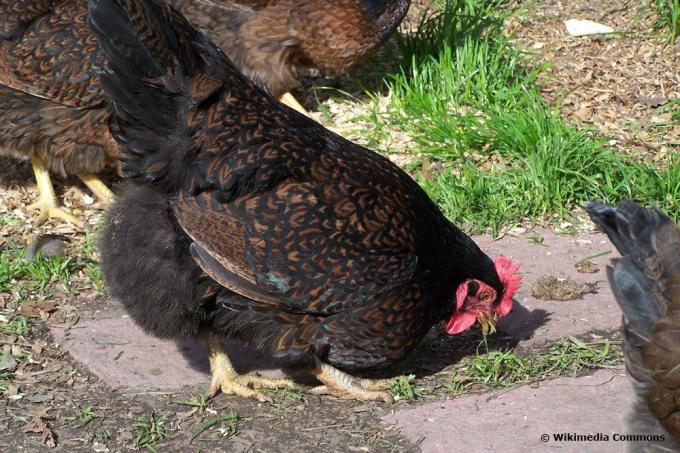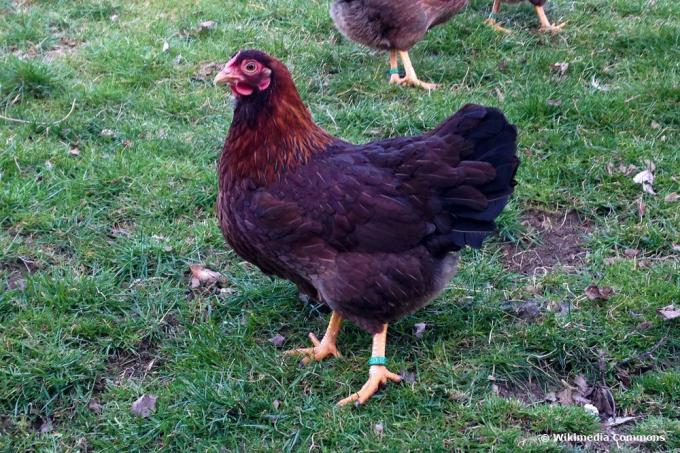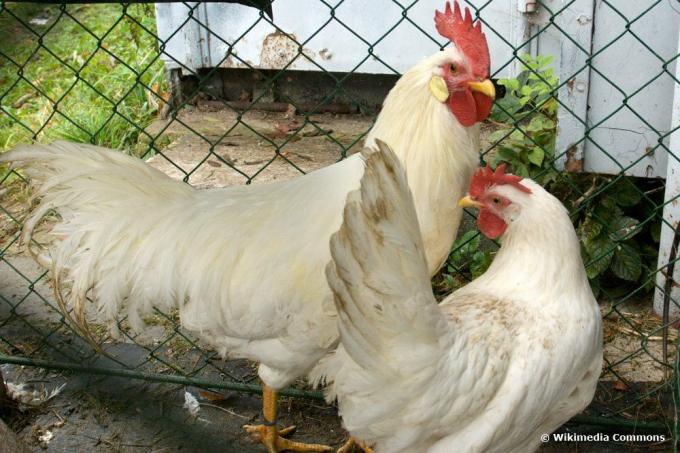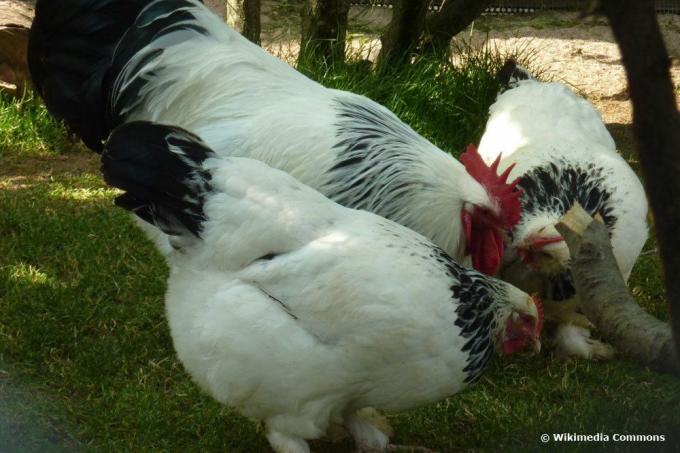
table of contents
- Selection and systematics
- Breeds from A - C
- Breeds from D - H
- Breeds from J - N
- Breeds from O - Z
Keeping different breeds of chickens in your own garden is very much in vogue. No wonder: you not only get fresh breakfast eggs every day, but you can also enjoy the hustle and bustle of the chickens.
Selection and systematics
In Germany alone there are around 180 breeds of chicken or Chicken species officially recognized. However, these include a lot of exotic species, some of which are only bred by a single breeder or are already extinct. In our selection, we have exclusively relied on breeds that are relatively easy to get. In addition, it was important to us that keeping the animals is largely uncomplicated. So-called hybrid breeds, which were bred solely for the highest possible laying performance, were excluded from the start. All information on weight and laying performance are average values that are only intended to provide an approximate guide. In addition, it should be noted that the laying performance naturally decreases with increasing age of the chickens.
Tip: It is best to buy chicks or young animals directly from the breeder. Information on this is provided by poultry breeders' associations or poultry shows or Poultry fairs that take place regularly in the country.
Breeds from A - C
Ancona
- Weight: 2 kg (hen), 3 kg (rooster)
- Egg color: off-white
- Egg weight: 50 g
- Laying capacity: 220 eggs per year
- Character: busy, lively

There was a time when the Ancona chickens were seen as the best laying breed of all. No wonder: with a very low weight, a hen can produce up to 220 eggs a year. That was before highly bred hybrid breeds became available. Today the Ancona can still be found on farms and self-caterers, but play practically no role in professional egg production. The bustling animals are very undemanding in keeping if they have a large run. The only thing is that they don't get along very well in the cold. They therefore absolutely need a warm stable for the winter.
Araucana
- Weight: 1.6 to 2 kg (hen), 2 to 2.5 kg (rooster)
- Egg color: green
- Egg weight: 50 g
- Laying capacity: 180 eggs per year
- Essence: trusting, robust

The Araucana chickens are some of the few breeds of chicken that lay green eggs. Green eggs are said to be healthier because they contain less cholesterol. This is generally incorrect and only applies to a very few individual eggs. With the green color, you can primarily score points visually. The Araucana, originally native to Chile, can become extremely tame, even trusting. This makes them absolutely uncomplicated to keep and very easy to care for. Since they have a splendid feather headdress, however, they should not be fed with pulpy food to avoid sticking.
Australorp
- Weight: 2 to 2.5 kg (hen), 3 to 3.5 kg (rooster)
- Egg color: brown
- Egg weight: 55 g
- Laying capacity: 200 eggs per year
- Essence: peaceful, trusting

The name already suggests: The Australorp originally come from hot Australia. Amazingly, they are still one of the types of chicken that can cope very well with the cold - at least with the cold that usually prevails here in winter. The Australorp are straightforward and therefore perfect for beginners in chicken husbandry. They usually become very trusting and can be touched without any problems. Oh yes: One of the special features of this breed is that both young cocks and young cocks get along with each other if there is enough space available.
Barnevelder
- Weight: 2.5 to 2.7 kg (hen), 3 to 3.5 kg (rooster)
- Egg color: brown
- Egg weight: 65 g
- Laying capacity: 180 eggs per year
- Nature: peaceful, trusting, robust

Barnevelders belong to the medium-sized chicken breeds. They are very easy to get along with and can also become surprisingly trusting. Typically, the Barnevelders are not particularly fond of flying. They are still very agile and excellent jumpers. For this reason, a sufficiently high fence must be available for free-range husbandry. The site shouldn't be too small either, but it doesn't have to be too big either. The very gentle animals can also be kept together with other types of chickens without any conflicts or fights.
Brahma
- Weight: 3 to 4 kg (hen), 3.5 to 5 kg (rooster)
- Egg color: yellow-red
- Egg weight: 53 g
- Laying capacity: 140 eggs per year
- Nature: peaceful, magnificent, robust

The Brahma are actually laying hens and not ornamental hens. Her magnificent plumage and the feather feet are somewhat irritating. Brahma clearly belong to those chicken breeds that look great. The attitude is relatively straightforward. However, you should make sure that the animals are not exposed to stress. They don't get along well with that. A location that is as quiet as possible for the exercise area and the stable is therefore highly recommended. Incidentally, when there is danger, Brahma chickens do not flee, but remain quiet and face the threat relatively calmly.
Brakel
- Weight: 1.75 to 2.25 kg (hen), 2.25 to 2.75 kg (rooster)
- Egg color: white
- Egg weight: 55 g
- Laying capacity: 180 eggs per year
- Nature: shy but robust

There are types of chickens that never become really trusting and that always show people a certain skepticism. The Brakel chickens are definitely one of them. As a rule, they cannot be touched or only very reluctantly. Otherwise, the animals are largely uncomplicated. And because they are also very robust and insensitive, they are particularly suitable for beginners. You need a medium-sized run - and it should definitely be fenced off or even provided with a roof. Because: Brakel chickens are excellent fliers and love to take to the skies.
Breeds from D - H
German salmon chicken
- Weight: 2.5 to 3.25 kg (hen), 3 to 4 kg (rooster)
- Egg color: white
- Egg weight: 60 g
- Laying capacity: 160 eggs per year
- Essence: robust, uncomplicated

Meanwhile, the German salmon chicken looks great. This has to do with its salmon-colored hues on the one hand, but also with its feather feet. In the meantime, however, the appearance of the salmon chicken plays a rather subordinate role. Much more important is that it can be used both as a laying chicken and as a meat supplier. The meat has a brilliant white color and is extremely tasty. However, if the salmon chickens do not have enough exercise, they tend to become extremely fatty. They are also robust, but should be used in extremely poor or bad weather conditions. must be housed in a stable in cold weather. The German salmon chicken is explicitly also suitable for beginners.
Dorking
- Weight: 2.5 to 3.5 kg (hen), 3.5 to 4.5 kg (rooster)
- Egg color: white
- Egg weight: 55 g
- Laying capacity: 140 eggs per year
- Nature: peaceful, robust, uncomplicated

Dorking chickens have been kept in the British Isles for more than 2000 years. Since the weather there is known to be often stormy and rainy, the animals are also extremely robust and resilient. Since they are also extremely happy to move around, they absolutely need an outlet that is definitely medium-sized. If they do not have enough exercise space, the dorking chickens tend to quickly become obese. By the way, they are one of the few chicken breeds that reliably lay eggs even in winter. However, one must then expect a lower laying performance.
Dresdner
- Weight: 2 to 2.25 kg (hen), 2.75 to 3 kg (rooster)
- Egg color: yellow-brown
- Egg weight: 60 g
- Laying capacity: 180 eggs per year
- Nature: very trusting, resilient

The Dresden chickens are also one of the types of chickens that are usually referred to as winter layers. So you don't stop laying eggs during the cold season. The laying performance is only slightly reduced. Cold and wet conditions have little or no effect on the very robust animals. In any case, they cope very well with the capricious weather conditions that are common in our latitudes. Even without a lot of exercise, Dresden chickens are excellent feed converters and do not easily put on fat. A rather small area is therefore completely sufficient for them. Typically, the people of Dresden become very trusting and also seek contact with people. This is another reason why they can be classified as completely uncomplicated and peaceful.
hamburger
- Weight: 1 to 2 kg (hen), 1.5 to 2 kg (rooster)
- Egg color: white
- Egg weight: 55 g
- Laying capacity: 180 eggs per year
- Character: shy, lively, robust

Hamburger chickens are anything but calm. On the contrary: They are extremely active, even lively, and only very rarely really come to rest. You have to move around a lot. A large or even unlimited run is therefore urgently recommended for these chickens. Since they are also very happy to fly and like to spend the night in trees, you should allow them this freedom. Besides, you don't have to worry about the animals not coming back. On the one hand they are very shy, but on the other hand they also know exactly where to get food. If you want to keep chickens in Hamburg, you should definitely have some experience in keeping chickens.
Breeds from J - N
Jersey Giant
- Weight: 3.6 to 4.5 kg (hen), 4.5 to 5.5 kg (rooster)
- Egg color: brown
- Egg weight: 60 g
- Laying capacity: 170 eggs per year
- Essence: peaceful, trusting

For Jersey Giant chickens, everything from the barn to the run has to be a little bigger. The giants, which originally came from the USA, belong to the large chicken breeds without any ifs or buts and therefore also need a lot of space. It also fits that they can also be counted among the very agile chicken species. When the animals are not sleeping, incubating or laying eggs, they are actually permanently active. Jersey Giant chickens are excellent meat suppliers, but they can also be proud of their laying performance. In addition, they are extremely peaceful animals that quickly become trusting and also like to be touched.
La Flèche
- Weight: 2.5 to 3 kg (hen), 3 to 4 kg (rooster)
- Egg color: white
- Egg weight: 70 g
- Laying capacity: 180 eggs per year
- Character: shy, very lively

La Flèche chickens are often referred to as devil chickens. The reason for this is, on the one hand, their horn-shaped comb, which is supposed to be reminiscent of the horns of the devil. On the other hand, the animals are usually black feathered throughout. But the devil chickens also show a behavior that can be described as wild to a certain extent. In any case, they are very lively and enthusiastic about movement. La Flèche chickens remain very reserved towards humans for a lifetime. They are extremely shy and cautious animals. Since they are also very good fliers, a fence with a minimum height of two meters should be installed if they are kept outdoors.
Leghorn
- Weight: 1.7 to 2.2 kg (hen), 2 to 2.7 kg (rooster)
- Egg color: white
- Egg weight: 60 g
- Laying capacity: 220 eggs per year
- Essence: very robust

Leghorn chickens are typical country chickens. Becoming was quite tame, but never particularly likes to be touched. With a laying capacity of 220 eggs in the first year, the hens are extremely effective egg producers. The roosters, however, are ideal as table chickens. Leghorns are keen on movement and good fliers. If they have the opportunity, they like to leave their traditional open-air area and then spend the night in the nearby trees. Leghorn chickens are very robust, but neither their comb nor their wattles can withstand extreme cold.
Lower Rhine
- Weight: 2.5 to 3 kg (hen), 4.5 to 4 kg (rooster)
- Egg color: yellow-brown
- Egg weight: 55 g
- Laying capacity: 200 eggs per year
- Essence: extremely peaceful, cozy

The Lower Rhine chickens also have to be classified in the rural chicken breeds. As a result, they are one of those types of chicken that not only provide lots of eggs, but also delicious meat. In their long row of breeding teeth, however, Lower Rhine residents actually have some extremely heavy species. To this day, the animals are extremely plump. Of course, this has an impact on their behavior: They are more comfortable, not particularly keen on movement and generally very peaceful. It goes with the fact that they practically never fly, even though they could. And yes, chickens from the Lower Rhine region become hand-tamed very quickly.
Breeds from O - Z
Plymouth Rock
- Weight: 2.5 to 3 kg (hen), 3 to 3.5 kg (rooster)
- Egg color: yellow-brown
- Egg weight: 55 g
- Laying capacity: 180 eggs per year
- Nature: peaceful, very trusting

Plymouth Rock chickens are something of the ideal family chickens. They are amazingly easy to tame and then regularly seek contact with people. Aggression seems to be largely unknown to them. The hens are extremely hard-working forage-seekers who are busy pecking more or less all day. The keeping of the animals is absolutely uncomplicated. A small fence is enough to keep them outdoors. However, the upper part of the enclosure should not be closed with a pole or a ledge, otherwise the animals will make themselves comfortable there and may even flee.
Sundheimer
- Weight: 2 to 2.5 kg (hen), 3 to 3.5 kg (rooster)
- Egg color: brown
- Egg weight: 60 g
- Laying capacity: 200 eggs per year
- Essence: peaceful, trusting

Sundheimer chickens are also perfect as family chickens. Not only are they peaceful and trusting, but they also like to be caressed. That is why they are sometimes kept in petting zoos. It is a medium-weight breed that is not necessarily keen to move, but can hardly fly either. In general, one can say that Sundheimers are extremely uncomplicated to keep. Only their magnificent feather feet need a little care. They should be cleaned from time to time so that no parasites can nestle there in the plumage.


